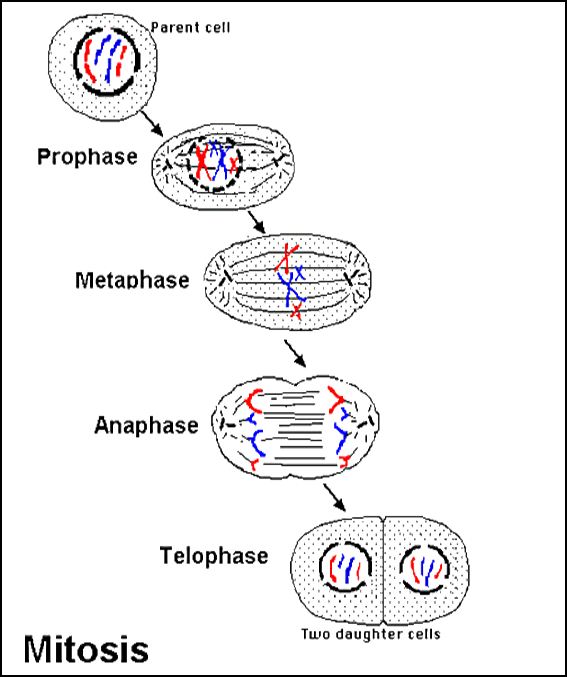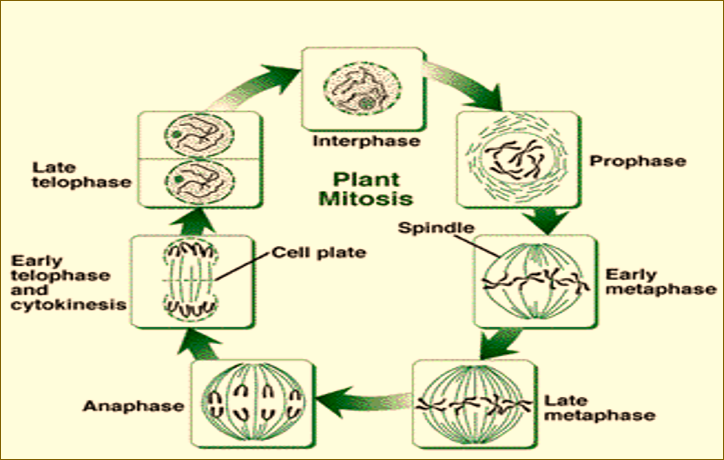
ASEXUAL
REPRODUCTION
Unit Overview
Asexual reproduction is the
topic of discussion for this unit. We will study how living things reproduce
from only one parent, how characteristics are passed down from one generation
to the next, and how asexual reproduction relates to the survival of the
species.
|
GLOSSARY
OF KEY TERMS |
||
|
asexual reproduction |
mitosis |
gene |
|
interphase |
prophase |
metaphase |
|
telephase |
metaphase |
anaphase |
|
telophase |
plantlets |
cuttings |
|
vegetative propagation |
rhizome |
bulbs |
|
bulblets |
fragmentation |
fission |
|
vegetative production |
regeneration |
budding plantlets |
Asexual Reproduction
Reproduction is the creation
of how living things reproduce. There are two different types of reproduction:
sexual reproduction and asexual reproduction. Sexual reproduction usually
requires two parents. In asexual reproduction, some living things
reproduce from only one parent. When an organism divides into two parts, it
reproduces asexually. Asexual reproduction is sometimes referred to as
nonsexual reproduction. This unit will introduce asexual reproduction and the
next unit will introduce sexual reproduction.
Sexual and asexual
reproduction has an important function in common. In both types of
reproduction, a special set of chemical “blueprints” are given to the
offspring. The blueprints determine what characteristics that living thing will
have. These characteristics are then passed from one generation to the next. In
both cases reproduction is essential for the survival of the species.
Asexual reproduction is the
simplest form of reproduction which occurs in many plants and simple animals.
The offspring are always genetically identical to the parent, or sometimes
commonly referred to as a clone. When we think in evolutionary terms, there are
disadvantages with this type of reproduction. Only identical individuals are
produced. This means that there is no variation. This can be useful in terms of
agriculture and horticulture, however, in the wild, an asexual population that
cannot adapt to a changing environment or evolve defenses against new diseases
is at risk of extinction.
Asexual Reproduction in Plants
Asexual reproduction does not
involve sex cells as would be common with sexual reproduction. This process is
reproduction by mitosis. Chromosomes copy themselves when a cell reproduces by
division into two new cells called daughter cells. Each daughter cell has the
same genes as the original cell. This process is called mitosis. A gene
determines the inheritance of a particular trait. Asexual plant reproduction
requires only one organism. New plants have the same genetic structure as the
parents.

There are 5 stages of plant
mitosis: interphase, prophase, metaphase, anaphase, and telophase. In interphase,
the cell is preparing for division by replicating DNA and organelles and
increasing cell size. In the second stage, prophase, the cell prepares
for nuclear division by condensing DNA into moveable packages called
chromosomes. In metaphase the cell prepares the chromosomes for division
by aligning the chromosomes at the cell equator (center), and attaching spindle
fibers from each new daughter cell pole to each chromosome at the centromere.
In anaphase, the spindle fibers pull the chromosomes apart. One half of
each chromosome moves to a new daughter cell. In telophase the cytoplasm
divides and the DNA condenses forming two nuclei. The new cell wall appears
between the two new nuclei to form two new daughter cells.
The following diagram show
plant cell mitosis.

Asexual reproduction includes
plants that grow from bulbs, feelers, and rhizomes. Branches grafted to trees
can also be classified as asexual reproduction, as can single-celled plants
such as algae.
Asexual reproduction can take
a number of forms in plants. One of these is vegetative
propagation. Many plants develop underground food storage organs
which over winter will develop into the following year’s plant. Some examples
might include bulbs, tubers (potatoes), and rhizomes. Plantlets can take
the form of runners that grow above ground and will start a new plant
(strawberries). As the heavy stems bend over or break off coming in contact
with the soil, the preformed roots will penetrate the soil and form a new
attachment for the plant. Under the right conditions, cuttings, or
grafts, will develop roots and grow into a new plant. Tissue culture involves
taking a few cells from a plant and growing them into a complete specimen.
Tissue culture is a type of cloning and will be discussed in a future unit on
genetics. A rhizome
is an underground runner that gives rise to new plants. Quackgrass
is a good example of this. It is a notorious invader of home gardens due to its
habit of sending long underground roots. Bulbs also have underground storage units that divide by
mitosis allowing many new plants to form new bulbs. An amaryllis, a house
plant, is an example of this. And then there are bulblets
which is a name coined for a form of asexual reproduction which is quite
unique. Some types of garlic will form small bulblets
in the place of a flower head. Bulblets will form on
the flower stem after the flowers have dried up. They send out a shoot while
still on the stem and then will break away from the stem and fall on moist soil
where they will start to grow again. Fragmentation is where parts of a
plant will break off and grow into a new plant. This may also include vegetative reproduction
in which a part of the plant, not specialized for reproduction, breaks off and
grows into a new plant. An example of this is a cactus which has brittle stems
and leaves. As animals walk by, they break off. Any piece of leaf tissue
touching the ground will form roots and grow into a new plant when the
conditions are right. Budding plantlets offer several plant buds of
tissue that develop into a miniature version of the parent plant. These may
even develop roots while still attached to the parent plant. Some examples of
this include a spider plant and a Mexican hat plant. Budding involves one
parent dividing its nucleus (genetic material) equally, but the cytoplasm
unequally. Yeast is an example of this.
Asexual Reproduction
in Animals
Asexual reproduction can be
advantageous for certain animals. Animals that remain in one particular place
and are unable to look for mates, would need to produce this way. Another
advantage is that the numerous offspring can be produced without “costing” the
parent a great deal of energy or time. Environments that are stable and have
very little change are the best places for organisms that reproduce asexually.
The cloned offspring are more likely to succeed in the same stable areas as
their parents.
There are three main ways of
asexual reproduction in animals. They are fission, fragmentation,
and regeneration. In fission, or budding as it is called, one or
more individuals are formed from the original. These clones may remain attached
physically to the parent or break away from it. If the buds remain attached,
colonies of coral form. Stony corals are an example of this type of
reproduction.

Gemmules,
a type of internal budding, allows an organism to survive under extreme
conditions. An example of this type of reproduction is a sponge.

Fragmentation is another way to reproduce asexually. The parent
breaks into different fragments, which will eventually form new individuals. As
many worms grow to full size, they spontaneously break up into 8 or 9 pieces.
Each of these fragments develops into a mature worm, and the process is
repeated. An example of this is certain flatworms known as planarians.

In regeneration, when
an animal capable of regeneration loses a body part, it can grow a replacement
part. If the lost body part contains enough genetic information from the
parent, it can regenerate into an entirely new organism. Planaria,
a flatworm, and echinoderms are examples of animals that can regenerate the
missing parts. They also have the ability to regenerate injured body parts as
well.
There are 5 stages of animal
mitosis: interphase, prophase, metaphase, anaphase, and telophase. In interphase
the cell is preparing for division by replicating DNA and organelles and
increasing cell size. If you were to look at the cell during this phase, you
might think it appears to be resting most of the time. However, it is carrying
on the ongoing functions of a cell. This is important to keep the cell in
balance. In prophase the cell is preparing for nuclear division by
condensing DNA into moveable packages called chromosomes. In this phase the
cell is getting ready to divide. In metaphase the cell prepares the
chromosomes for division by lining up the chromosomes across the middle of the
cell. They divide so that there are now two copies of each one. The spindles
are about to pull copies of the chromosomes to each end of the cell. In anaphase
you can see the chromosomes being pulled toward the poles of the spindles. This
process duplicates and separates the chromosomes so that each new cell will be
an exact copy of the old one. In the last phase, telophase, the cell is
ready to reconstruct a nucleus at each end of the cell. The chromosomes are
ready to be enclosed in a nucleus again. The spindles are disappearing and
their job is finished.
Mitosis and Humans
Why is the process of mitosis
important in humans? How is it related to this topic? Actually mitosis is going
on in our bodies all the time. As our hair grows, the cells are dividing
asexually. When our fingernails grow, there is also asexual division again. But
that’s not all. When we cut our finger and the skin heals, the cells go through
this same process. And when our bodies grow, this is how our bones get longer
and tissues grow.

Why choose asexual
reproduction?
Maybe we should ask, why not?
We already know that asexual reproduction is an efficient way of reproducing
and avoids all sorts of problems. And it is also advantageous in that it can
create individuals rapidly and in large quantities. Asexual reproduction tends
to be genetically static. This may doom the species to extinction if they are
unable to adapt to a changing environment. Plants and animals that reproduce
asexually may have evolved this way because they are fixed in place or can’t
move very far.
Maybe sexual reproduction, as
we will discuss in the next unit, will remain the favorite because it provides
a way to weed out harmful mutations that may arise. Perhaps the need to adapt
to changing environments has caused sexual reproduction to remain the method of
choice for most living things.
Unit Extensions:
Suggested field
trips:
·
Visit a
greenhouse and try to identify the plants that reproduce asexually.
Careers to explore:
·
Horticulturist
·
Biologist
Suggested
topics for further research:
·
horticulture
·
genetics
Unit Conclusion
Asexual reproduction is
defined as reproduction from one parent. This type of reproduction plays an
important role with plants and animals. This can be productive in the field of
agriculture and horticulture, however, may not be the best means of
reproduction in evolutionary terms. The stages of mitosis in both plants and
animals were discussed as well as the various types of asexual reproduction.